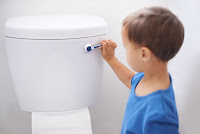Peace and Discipline: The Hallmarks of Normalization
by Rhonda Lucas-Sabater
 |
| Concentration while playing the Bells |
At the end of their time in the Montessori Primary prepared environment, what are some of the qualities that we want our children to have? A major outcome of our work in guiding the young child in his work of self-construction, is the development of inner peace. However, we cannot talk about peace without talking about discipline.
Peace and discipline go hand in hand. You cannot have one without the other. For the young child, inner peace needs to be established before there can be outer peace. In the same vein, inner discipline, or self-discipline needs to be developed first, before the child can be expected to conform to outer discipline. The foundation on which the child constructs inner peace and self-discipline, is of course, concentration. Maria Montessori writes in The Absorbent Mind that , “the first essential for the child’s development is concentration. It lays the whole basis for his character and social behavior”. Concentration develops through work or activity.
This brings us to the the prepared environment, and the crucial role it plays in helping the child during this period of self construction. Maria Montessori writes, “The child whose attention has once been held by a chosen object, while he concentrates his whole self on the repetition of the exercise, is a delivered soul in the sense of the spiritual safety of which we speak. From this moment there is no need to worry about him--except to prepare an environment which satisfies his needs, and to remove obstacles which may bar his way to perfection.” It is in the prepared environment of the classroom and the home, where the child experiences and observes and has the opportunity to develop inner peace and self-discipline through her interactions with the adults, her peers and the materials.
The Grace and Courtesy lessons are also vital to this process as the children learn how to respond to conflict, learn the social graces of the environment and develop that social cohesion as they become a community. The social cohesion is a clear sign that the children have achieved some level of inner peace and self-discipline. We can sometimes see glimpses of it throughout the day: people speaking quietly, for instance, so as not to disturb others; or children returning materials to the shelves and fixing them neatly so that they are ready for the next person who may want to use them. However, Dr. Montessori cautions that, “...cohesion alone is not enough to set up a society...the force of cohesion...is something that needs to be directed by an attachment to ideals.”

The adults are modeling all the appropriate behavior and giving the necessary lessons to help the children at every stage of development. In the Primary prepared environment, the adults are serving in the role of guide, helping the child connect with the real world and with her own inner guide, and through the work of her hands, develop that ability to concentrate, thereby laying the foundation for the development of inner peace and self-discipline, what we call, normalization. A normalized child, then, is one who is peaceful, joyful, is able to concentrate, is self-disciplined, has a love of work, has a love of learning--and normalization is the culmination of all our work with the child in the First Plane of Development.
Rhonda Lucas-Sabater is an AMI Auxiliary Trainer at the Primary (3-6) level. She is the mother of five Montessori children and the co-founder of a public charter Montessori school in Washington, DC. She is also AMI trained at the Assistants to Infancy (O-3), Primary (3-6), and Elementary (6-12) levels and is an AMI certified Adolescent guide.

